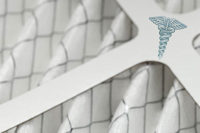Engineers’ daily challenges include calculations for outside air, supply air, and return or exhaust air flows — all while balancing mandated code requirements with owners’ expectations for performance, equipment first-cost, and future energy costs. This often involves difficult trade-offs that require critical comparison and careful analysis. These are not simple arithmetic formulas. Clearly, increasing OA airflow — highly valued for comfort and safety — could result in disastrous energy impacts. So, what is the “right” amount of outside air? How do we meet ventilation codes and standards with an HVAC system that is genuinely cost-effective and energy-efficient?
The SGJJR design team addressed these questions for an 80,000-sq-ft medical office building located in Hattiesburg, MS. Given the limited budget, the HVAC system was not complex or flashy, and the design team was challenged to find innovative ways to design a cost-effective system with a low operation cost.
Because the building was a medical office building, the system had to meet both ASHRAE 62.1 and ASHRAE 170 (Ventilation for Healthcare Facilities). VAV boxes with hot water reheat met the physical, cost, and performance requirements of the project; the design team had to find the right balance between the number of VAV boxes and the amount of outside air required to meet the comfort criteria for the spaces. The intent was not only to separate interior zones from exterior zones as is typically done, but additionally to “isolate” medical spaces from office spaces.
Although ventilation calculations sometimes appear to be a “no brainer,” this article will show how important it is to properly identify spaces and their function, how to automate the calculations, and how to perform trade-offs. A flashy system is not required to achieve energy savings; sometimes the “little” things make a big difference. Trade-offs can and should be performed to determine minimum outside airflows and minimum VAV box settings. The available variables are minimum system airflow, system ventilation efficiency, and minimum system outside airflow. These trade-offs have a significant impact on the overall building efficiency.
The example project involved the construction of a heart and vascular center for the Hattiesburg Clinic, which is part of the Forest General Campus in Hattiesburg, MS. Budget constraints were severe, resulting in an economical first-cost HVAC system comprising four roof-mounted VAV packaged DX rooftop units and VAV boxes with hot water reheat. The heating system consisted of high-efficiency gas fired condensing boilers and hot water pumps arranged in a variable primary configuration. Each packaged rooftop unit was designed to serve only one floor.
As with any project that has significant budget constraints, one of the main questions that the design team faced was: How can we bring value to the client? The design team knew they must develop an HVAC system that not only meets the functional use but also exceeds the energy benchmark for a medical office building of this type.
APPLICABLE STANDARDS
There are several ventilation guidelines that govern ventilation in health care facilities; the two applicable to this project are:
- ANSI/ASHRAE/ASHE Standard 170 — 2008, Ventilation of Health Care Facilities
- ASHRAE 62.1-2007 — Ventilation for Acceptable Indoor Air Quality
The ventilation guidelines were governed by two sources: 1)The Mississippi’s Department of Health states that health care facilities are required to comply with Facility Guidelines Institute (FGI) Guidelines for Design and Construction of Health Care Facilities, the 2010 Edition (which, in turn, references the ANSI/ASHRAE/ASHE Standard 170 — 2008, Ventilation of Health Care Facilities for the requirements governing ventilation for all areas within a health care environment), and 2) The authority having jurisdiction also states that the project shall comply with the International Mechanical Code (2006) (which, in turn, references the ASHRAE Standard 62.1 — 2007, Ventilation for Acceptable Indoor Air Quality).
The building includes a combination of office spaces and health care spaces. The design team used the Ventilation Rate Procedure as described in ASHRAE 62.1 — 2007 and ASHRAE 170.
Because SGJJR has adopted the Revit BIM platform for the design of all projects, the engineering team created schedules in the Revit MEP template to automate part of the ventilation calculation for both ASHRAE 170 and ASHRAE 62.1 — 2007. This approach allowed the design team to both reduce calculation times and allow the ventilation calculation to fully track the seemingly never-ending architectural changes which occur during the design process. When multiple ventilation standards apply, the more stringent of the code governs; this requires careful and critical formula and data input.
The zoning criteria for most spaces in healthcare facilities are more stringent than commercial buildings due to the increased comfort criteria for patient care. The ideal scenario for comfort would be a dedicated VAV box for each and every office space and exam room. However, good (conservative) engineering design practice usually recommends a maximum of one VAV box per four to five rooms, with only spaces having two exposures being assigned a separate VAV box. This zoning criterion was critical in reducing the overall cost of the mechanical system.
Each floor of the building, with the exception of the first floor, followed the pattern of interior medical spaces surrounded by perimeter office spaces. This very deliberate programming, repeated dependably on most floors, facilitated the design team’s zoning plan.
ASHRAE 170 dictates minimum air changes per hour (ACH) flow rates of outside air, supply air, and exhaust air based room type. In contrast, ASHRAE 62.1 — 2007 requires flow rates based on both cfm/area and cfm/person, according to room type, room area, supply air temperature, and number of occupants. While not overly complex, the calculations to reconcile these two methods can be long, detailed, and time-consuming.
VENTILATION CALCULATIONS PROCESS
The system for the building is a multi-zone recirculating system as described in ASHRAE 62.1 — 2007; which states that the outdoor air intake flow (Vot) shall be determined in accordance with Sections 6.2.5.1 through 6.2.5.4. Table 6-3 in the standard describes how to determine the primary air fraction (Zp) along with the corresponding System Ventilation Efficiently (Ev). This analysis will not address the full calculation of the outside air intake flow (Vot) because the manual fully describes this procedure. The intent of this analysis is to show how much you can vary the zone primary airflow with the outside airflow and at the same time minimizing the zone energy consumption.
The example, analysis presented in this article illustrates the air handling system serving the second floor of the building. In order to use the Ventilation Rate Procedure, ASHRAE 62.1 requires that overall System Ventilation Efficiency be between 0.6 and 1.0.
The first step is to determine the maximum amount of outside air required which corresponds to an Ev of 0.6. Typically, the spaces with the biggest impact on system ventilation efficiency are conference rooms, break rooms, and multi-purpose rooms. This is attributable to the high occupancy levels for these rooms, which drives up the outside air volume. It is good practice to zone these spaces on their own because they will dictate the outside air volume for the zones and hence the overall energy use of the zone.
In some instances, spaces will require an increase in zone primary airflow to satisfy their heating loads. The minimum supply air to a space should be selected as the larger value between the minimum heating airflow and the airflow corresponding to an Ev of 0.6.
The next step is to determine the minimum amount of outside air required for each zone. The graph below shows the relationship between Ev and the minimum outside airflow required for the example system. The more efficient a system is, i.e. the higher the Ev value, the less outside air is required to be delivered to the spaces, which in turns means that less energy is consumed to treat the outside air. Table 1 and Figure 1 show the relationship between Ev and system outside airflow.
In order to increase Ev, the minimum zone airflow must be increased. This means that the minimum airflow at the rooftop unit fan will have to be increased. Table 2 and Figure 2 show the relationship between Ev, outside airflow, and minimum system airflow.
Figure 2 shows that in order to achieve a system ventilation efficiency Ev of 1.0, the system zone primary airflow will have to be increased by approximately 42% while achieving a reduction in outside airflow of 35%. At this point, we have to look at the impact on the system energy consumption. A 42% increase in airflow will have a significant impact on the energy use of the system. The intent is to find the “sweet spot” regarding the Ev, the related amount of outside airflow, and the system primary airflow.
Designers should not forget to account for the reheat energy required when increasing the minimum supply airflow (at the given SA temp) to a space or a zone. Typically, the interior spaces require less supply airflow for heating than the airflow required to achieve an Ev of 0.6. However, in our project, most of the interior spaces are medical type spaces, which require an increase of the minimum supply airflow in order to meet the ASHRAE 170 minimum air changes requirements, in turn making reheat an even more important consideration.
In addition to reheat energy, one should account for the increase in fan and pump energy consumption. Without using dedicated energy analysis software, engineers can use the affinity laws for pumps and fans to estimate the increase in system energy consumption. This approach should save time, particularly in the early stages of the design.
Using Ev = 0.6 as a baseline, Figure 3 shows an inflection point at Ev = 0.8. After this point, the energy savings due to the reduction in outside airflow begins to be overridden by the increase in system energy consumption. As the System Ventilation Efficiency (Ev) approaches 0.9, more energy will be used to condition “excess” zone primary air than the energy that will be saved from the reduction in outside airflow. Based on project setpoints and design conditions (97/76 DB/WB entering conditions and 55/54.5 DB/WB leaving air) each 100 cfm of outside air will require approximately 7,413 Btu/h to be conditioned.
For this particular system, the “artificial” increase in zone primary airflow in order to achieve an Ev of 0.8 was made possible mainly because the majority of the office type spaces were located on the perimeter and had relatively high zone primary airflow. There were seven office-type spaces (i.e. break rooms) that “prevented” an increase in the system ventilation efficiency. By increasing the minimum zone airflow to these spaces, the Ev increased from 0.6 to 0.8 with a minimal impact on the overall system energy consumption. Engineers should ensure that the minimum airflow for these spaces is analyzed properly to prevent these spaces from driving up the final outside air for the air handling unit.
In conclusion, regardless of the project size or the simplicity of a mechanical system, energy conservation measures can be “discovered” and implemented at no extra cost to the project. For this project, we were able to use this method to reduce the outside air, which is always the main culprit for the high energy use in healthcare buildings. The engineer will need to understand the relation between system ventilation efficiency, outside air, and minimum primary airflow in order to fully materialize this energy saving for HVAC systems.
A small artificial increase in the zone primary airflow of “critical” spaces can have a significant impact on the overall building energy consumption for the zone and hence on the overall building. Identifying this point of inflection will allow the engineer to understand the point at which an increase in minimum primary airflow will be unsustainable. Energy efficiency extends beyond overall system selection and controls; optimizing the outside air calculations will have a positive impact on energy savings.
References:
1.ANSI/ASHRAE/ASHE Standard 170 — 2008, Ventilation of Health Care Facilities
2. ASHRAE 62.1-2007 — Ventilation for Acceptable Indoor Air Quality











